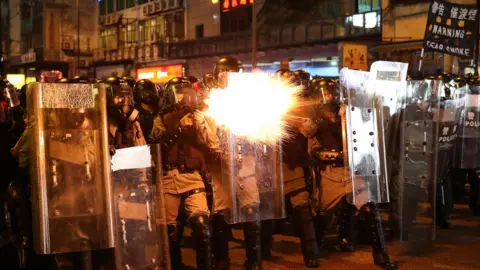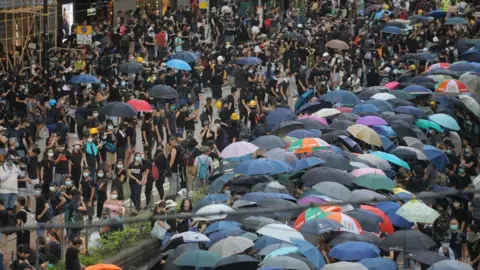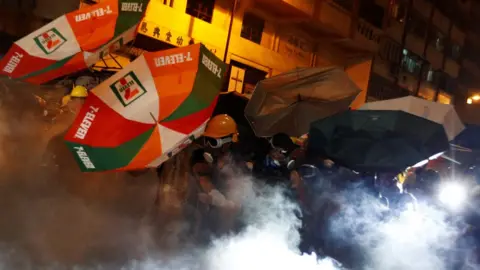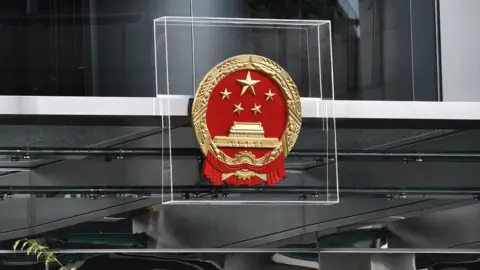Hong Kong protests: Police fire tear gas near China's liaison office
Hong Kong has seen a second day of violent clashes between police and pro-democracy demonstrators who are also angry at alleged police brutality.
Police fired tear gas and rubber bullets at protesters trying to reach the Chinese government's office.
Tens of thousands of demonstrators have taken over streets near Sai Wan and Causeway Bay on Hong Kong Island.
Hong Kong has seen eight consecutive weekends of anti-government and pro-democracy protests.
It is ranked as one of the safest cities in the world - but recent protests have been followed by violent clashes between demonstrators, police and masked men wielding sticks suspected of being criminal gang members.
Sunday's protests saw activists wearing protective helmets and goggles erecting barricades at several different locations and chanting "free Hong Kong".
The protests began as a police-authorised gathering in a park in the central business district before protesters defied the authorities and marched west towards the Chinese liaison office in Sai Wan and east towards the Causeway Bay shopping area.
Hundreds of police blocked the protesters from reaching the Chinese liaison office. The building had been fortified with plastic barricades and a Chinese government emblem above the front door had been covered with a plastic shield, Reuters news agency reported.
 EPA
EPALast Sunday the office was targeted by protesters who wrote graffiti and threw paint on its walls. Chinese officials said this was a challenge to Beijing's authority that would not be tolerated.
Some protesters chanted "reclaim Hong Kong" and "revolution of our times", or held up banners that read "end the violence".
Meanwhile in the Causeway Bay shopping area, protesters with helmets and masks waited for police as tourists carrying shopping bags, including many from mainland China, continued to walk the streets.
Allow X content?
How did we get here?
Demonstrations began when the Hong Kong government introduced a controversial bill that would have enabled extraditions to mainland China.
 AFP
AFP Reuters
ReutersIt sparked huge protests as critics feared the bill would undermine Hong Kong's freedoms, and be used to target political activists.
The row intensified as police were accused of using excessive force on anti-extradition bill protesters.
Tensions increased further last Sunday, when suspected triad members descended on a subway station in Yuen Long, beating protesters, passersby and journalists with sticks.
Demonstrators accused the police of colluding with the triads - claims angrily denied by the police.
The authorities say they have arrested 12 people over the attack, including nine men with links to triads.
The anti-extradition protests have morphed over time into a wider movement.
While the government has paused work on the extradition bill, protesters now want it withdrawn completely, as well as an independent inquiry into police violence, and democratic reform.
They want the territory's leader, Carrie Lam, who is not democratically elected, and whose handling of the crisis has been widely criticised, to resign.
Some protesters have also expressed their anger at the mainland Chinese government, which they say has been eroding freedoms in Hong Kong.
Last week, demonstrators stormed the Chinese government's office and defaced the national emblem.
The authorities have now installed a protective casing around the sign.
 AFP
AFPCould the Chinese military get involved?
As a former British colony, Hong Kong has its own legal and judicial systems, and has been promised "a high degree of autonomy" from the Chinese government, except in foreign and defence affairs.
China's People's Liberation Army (PLA) does have troops stationed in Hong Kong, but they are not expected to interfere in local issues.
However, the law does permit Hong Kong's government to request assistance from the PLA for purposes of maintaining public order, or disaster relief.
Last week China's defence ministry spokesman condemned protesters who had vandalised the government's offices, and said there were "clear stipulations" in the law allowing Hong Kong's leaders to ask the army for help.
Hong Kong's government and police have stated in recent weeks that they have no plans to involve the army - while some commentators argue that China would consider using its troops in Hong Kong to be too politically risky.

Timeline of events 2019
3 April - Hong Kong government introduces amendments to the city's extradition laws to the legislature that would allow criminal suspects to be extradited to mainland China.
9 June - In the first of many huge protests against the changes, an estimated million people march to government headquarters.
12 June - Anti-extradition bill protesters block roads and try to storm government buildings - police fire tear gas, rubber bullets and bean bag rounds at protesters, in the worst violence the city has seen in decades.
15 June - Hong Kong leader Carrie Lam indefinitely delays the bill in a dramatic reversal.
16 June - Despite this, an estimated two million people take to the streets demanding the complete withdrawal of the bill, an investigation into alleged police violence, and Carrie Lam's resignation.
21 June - As anger grows towards police, protests blockade police headquarters for 15 hours. They now also want protesters that were arrested to be exonerated.
1 July - On the anniversary of Hong Kong's handover from the UK to China, the Legislative Council (LegCo) building is stormed and broken into by protesters.
21 July- Protesters deface China's Liaison Office in Hong Kong. That same night mobs of men wearing white shirts attack protesters and commuters in Yuen Long station, near mainland China, in a new escalation of violence.

